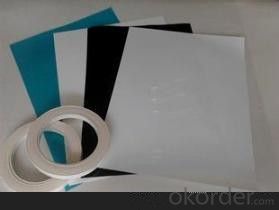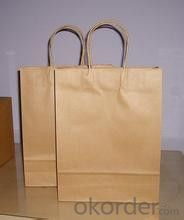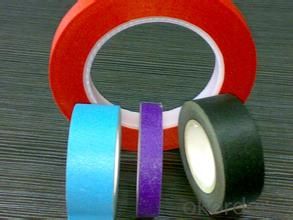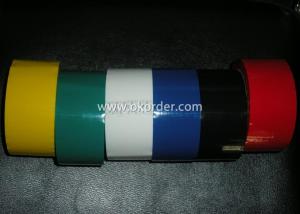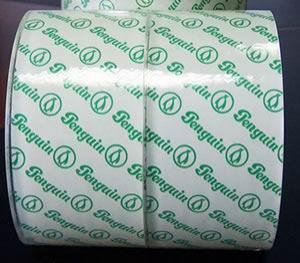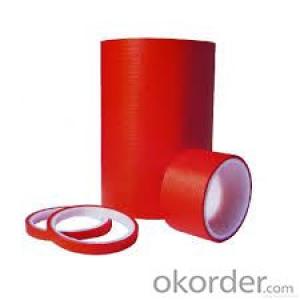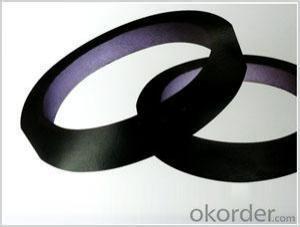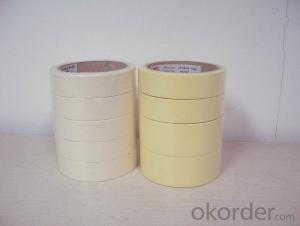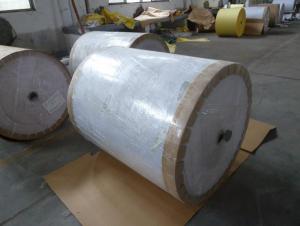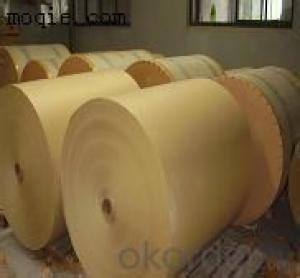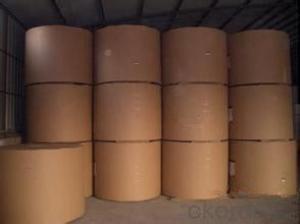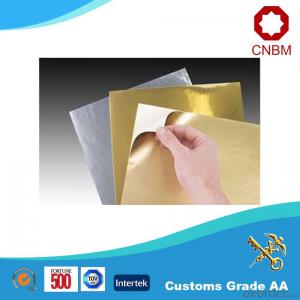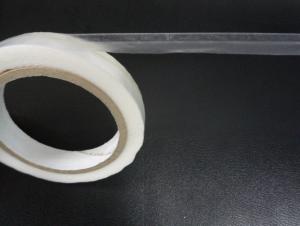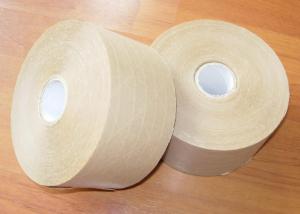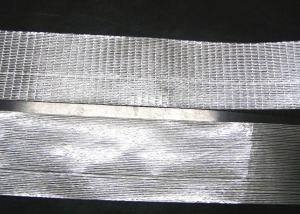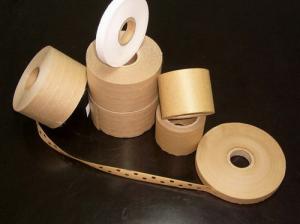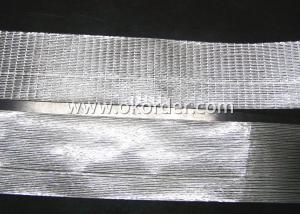Brown Kraft Paper Tape Three with Release Liner
- Loading Port:
- China Main Port
- Payment Terms:
- TT OR LC
- Min Order Qty:
- -
- Supply Capability:
- -
OKorder Service Pledge
Quality Product, Order Online Tracking, Timely Delivery
OKorder Financial Service
Credit Rating, Credit Services, Credit Purchasing
You Might Also Like
Quick Details
Paper Type: | Craft Paper | Use: | carton box | Coating: | Uncoated |
Compatible Printing: | Inkjet Printing | Feature: | Moisture Proof | Pulp Material: | Mixed Pulp |
Pulp Style: | Recycled | Pulping Type: | Chemical-Mechanical Pulp | Place of Origin: | China (Mainland) |
Brand Name: | CNBM | Model Number: | DF-5 | craft paper: | corrugated carton |
- Q: What are the benefits of using UV-resistant packaging tape?
- The benefits of using UV-resistant packaging tape include protection against fading or discoloration caused by exposure to sunlight, increased longevity of the packaging tape, and maintenance of the tape's adhesive strength even in outdoor or high-temperature environments.
- Q: How does the tape used for packing the finished product in the workshop be accounted for?
- That's what you have learned in the package: low value, consumable goods are not available at all, so it's OK to write the package.
- Q: How do I prevent packaging tape from tearing during removal?
- To prevent packaging tape from tearing during removal, there are a few strategies you can try: 1. Apply heat: One effective method is to use a hairdryer or heat gun to warm up the tape. The heat softens the adhesive, making it easier to peel off without tearing. Be careful not to overheat or burn the tape, though. 2. Use a cutting tool: If the tape is difficult to remove, you can use a sharp cutting tool like a utility knife or scissors to carefully cut through it. This way, you can avoid tearing the tape and remove it in smaller, more manageable sections. 3. Slow and steady approach: Take your time and be patient when removing the tape. Pull it slowly and at a low angle, applying gentle pressure to avoid tearing. If you encounter resistance, stop and try a different angle or apply a bit of heat to loosen the adhesive. 4. Seek assistance from a solvent: If the tape is particularly stubborn, you can try using a solvent like rubbing alcohol or adhesive remover. Apply a small amount to a cloth or cotton ball and gently rub it on the tape to dissolve the adhesive. Test the solvent on a small, inconspicuous area first to ensure it doesn't damage the surface. 5. Choose the right tape: Using high-quality packaging tape can also help prevent tearing during removal. Look for tapes with strong adhesion and good tensile strength. Reinforced or heavy-duty tapes tend to be more resistant to tearing. By employing these techniques and being cautious, you can successfully remove packaging tape without tearing it.
- Q: How do I prevent packaging tape from unraveling?
- Here are some helpful tips to prevent packaging tape from unraveling: 1. Ensure a clean surface: Prior to applying the tape, ensure that the surface is clean and free from any dirt or debris. This will enhance the tape's adhesion and prevent it from unraveling. 2. Invest in high-quality packaging tape: Opt for durable packaging tape that possesses a strong adhesive. Cheaper or low-quality tapes tend to unravel more easily. 3. Cut the tape correctly: When cutting the tape, utilize a sharp knife or scissors to create a neat edge. This will eliminate any loose ends that may lead to unraveling. 4. Apply ample pressure: Once the tape is affixed to the surface, exert firm pressure along its entire length. This will guarantee proper adhesion and minimize the chances of unraveling. 5. Overlap the tape: To provide additional support, slightly overlap the tape onto itself. This creates a stronger bond and reduces the likelihood of unraveling. 6. Properly store the tape: When not in use, store the tape in a cool and dry place, away from direct sunlight. Extreme temperatures and moisture can weaken the adhesive, resulting in tape unraveling. 7. Utilize tape dispensers: Consider using a tape dispenser equipped with a built-in cutter. This will not only simplify the cutting process but also yield a clean edge, preventing unraveling. By adhering to these guidelines, you can significantly reduce the risk of packaging tape unraveling and ensure that your packages remain securely sealed.
- Q: Can packaging tape be used for other purposes besides packaging?
- Packaging tape is not limited to packaging; it can be utilized for various purposes. With its strong adhesive properties and durability, it serves a multitude of functions. For instance, it proves useful in household repairs like mending broken book spines or securing loose cables. Moreover, it finds its place in crafting projects, allowing the creation of temporary or permanent decorations, durable envelopes, and even makeshift labels or item organization. Additionally, it comes in handy for quick fixes, like sealing small leaks or cracks in pipes or containers until a more permanent solution is discovered. The versatility of packaging tape ensures its usefulness in diverse situations, making it an essential tool for any home or office, surpassing its initial purpose of packaging.
- Q: Can packaging tape be used for sealing camping or outdoor gear?
- Certainly! Packaging tape is suitable for sealing camping or outdoor equipment. Its primary purpose is to securely seal boxes and packages, offering a sturdy and long-lasting seal. It can also be utilized to seal openings or tears in fabric-based camping gear like tents, sleeping bags, backpacks, and other items. However, it is crucial to acknowledge that packaging tape might not be as effective as specialized outdoor gear repair tape, which is explicitly crafted to endure harsh outdoor conditions and provide a more resilient and enduring seal. Moreover, when using packaging tape to seal camping gear, it is advisable to clean and dry the area before applying the tape to ensure an appropriate bond.
- Q: How does packaging tape differ from masking tape?
- Packaging tape differs from masking tape primarily in terms of their intended uses and adhesive properties. Packaging tape is specifically designed for sealing boxes and packages, providing a strong and durable bond that can withstand shipping and handling. It is usually made of a strong material like polypropylene and has a strong adhesive that sticks well to various surfaces, including cardboard and plastic. On the other hand, masking tape is designed for temporary applications like painting and crafting. It has a less aggressive adhesive that allows for easy removal without leaving residue or damaging surfaces. Masking tape is typically made of paper and is not as strong as packaging tape, making it unsuitable for heavy-duty tasks like sealing boxes for shipping.
- Q: Does packaging tape come in different adhesion levels for various surfaces?
- Yes, packaging tape does come in different adhesion levels for various surfaces. There are different types of packaging tapes available in the market, each designed to adhere to specific surfaces. For example, there are packaging tapes with low adhesion levels that are ideal for delicate surfaces such as paper or cardboard, as they provide a secure bond without damaging the surface when removed. On the other hand, there are high adhesion packaging tapes that are specifically formulated for sticking to rough or uneven surfaces, such as plastic or metal. These tapes have a stronger adhesive to ensure a secure hold in challenging environments. Additionally, there are also packaging tapes with medium adhesion levels that are versatile and suitable for general-purpose usage on a variety of surfaces. The different adhesion levels allow users to choose the most appropriate packaging tape based on the specific surface they need to adhere to, ensuring optimal performance and reliability.
- Q: Does packaging tape have a specific weight capacity?
- Yes, packaging tape does have a specific weight capacity. The weight capacity of packaging tape depends on its thickness, width, and quality. Generally, packaging tapes are designed to securely seal boxes and packages, and their weight capacity is determined by their adhesive strength and durability. Most standard packaging tapes have a weight capacity of around 20 to 30 pounds. However, heavy-duty packaging tapes are available that can handle weights of up to 50 pounds or more. It is important to consider the weight of the package or box being sealed and choose a packaging tape that can handle the specific weight capacity to ensure a secure and reliable seal.
- Q: What are the different adhesive options available for packaging tape?
- There are several adhesive options available for packaging tape, each with its own unique characteristics and suitability for different applications. 1. Acrylic adhesive: This is the most common type of adhesive used in packaging tape. It offers good adhesion to a wide range of surfaces and has excellent clarity, making it ideal for transparent or light-colored packaging. Acrylic adhesive also provides a long-lasting bond and performs well in both hot and cold temperatures. 2. Hot melt adhesive: This type of adhesive is formulated to provide an instant and strong bond. It has a high initial tack and excellent holding power, making it suitable for heavy-duty applications or sealing boxes with rough or recycled surfaces. Hot melt adhesive is also resistant to aging and performs well in extreme temperatures. 3. Natural rubber adhesive: This adhesive offers excellent adhesion to a variety of surfaces, including recycled materials. It has a high level of tackiness, which ensures a secure bond even on challenging surfaces. Natural rubber adhesive is also resistant to UV light and aging, making it a good choice for long-term storage or outdoor use. 4. Synthetic rubber adhesive: Similar to natural rubber adhesive, synthetic rubber adhesive provides strong adhesion to a wide range of surfaces. It offers good resistance to aging, moisture, and temperature changes, making it suitable for various packaging applications. 5. Solvent-based adhesive: This type of adhesive is known for its high initial tack and excellent bonding strength. It provides a quick bond and performs well on challenging surfaces such as corrugated cardboard or recycled materials. However, solvent-based adhesive may emit strong odors and require additional safety precautions during use. When choosing an adhesive option for packaging tape, it is essential to consider factors such as the type of packaging material, surface conditions, environmental conditions, and specific requirements of the application. Consulting with adhesive manufacturers or suppliers can help determine the most suitable adhesive for your packaging needs.
Send your message to us
Brown Kraft Paper Tape Three with Release Liner
- Loading Port:
- China Main Port
- Payment Terms:
- TT OR LC
- Min Order Qty:
- -
- Supply Capability:
- -
OKorder Service Pledge
Quality Product, Order Online Tracking, Timely Delivery
OKorder Financial Service
Credit Rating, Credit Services, Credit Purchasing
Similar products
Hot products
Hot Searches
Related keywords



